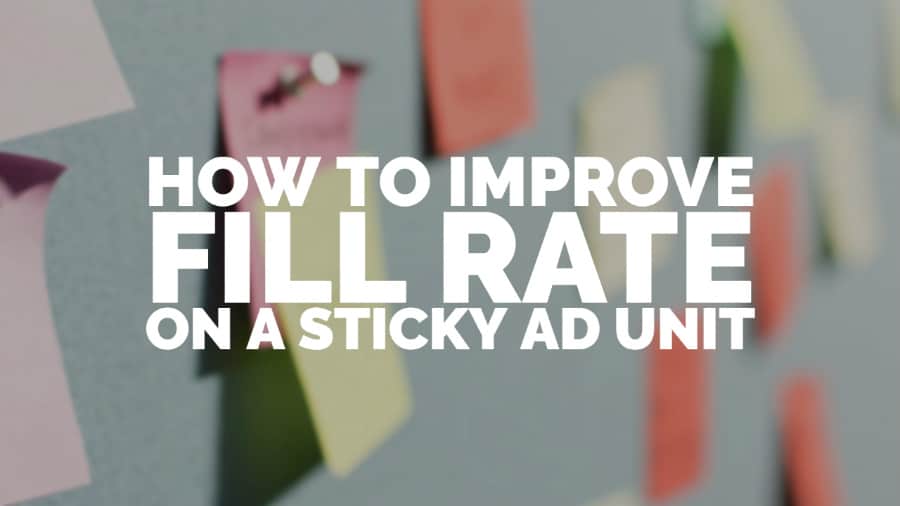
Sticky ad units, also known as anchor ads, ‘stick’ to part of the viewable area of a webpage as the user scrolls up and down. The huge advantage for advertisers is that their ad unit will be visible the entire time that the users are viewing content on the page, instead of disappearing from view as the user scrolls. They’re particularly useful on mobile pages, usually as a thin bar on the bottom of the screen that is almost always in or very near the user’s eye line.
They are valuable sources of revenue for publishers, meaning that a low fill rate or a significant drop in fill rate can have a more pronounced effect on overall revenue than a traditional display ad.
It’s essential to consider RPM in conjunction with the fill rate. Just like with any ad unit, it’s possible that as you head towards 100% fill, you might have to compromise on rates to achieve that fill. Not only will this lower the RPM, but you might start to see poorer-quality or irrelevant ads that could have an impact on both page load times and user experience for an extremely marginal benefit.
If the demand for ad space on your site is very high, then your fill rate will be trending towards 100%, but a fill rate of 50% might not indicate a disaster. We can’t tell you what fill rate you should be aiming for because every site is different, but sudden drops or very low fill rates can be strong indicators of a problem. The ideal ad strategy will not just have revenue on ad unit or ad unit type but will see revenue come from a balanced range of sources.
In this article, we’re going to list some of the things to consider if you have low fill rates on sticky ads to improve your revenue.
Check for page load times, and how long the ad took to render. If it is slow to load, you risk dropping impressions. Also, ad networks don’t like bidding for impressions from sites that aren’t able to deliver the impression they’ve requested.
Some users on your site may (and probably are) running adblocking. There are ways around this. Examine the site critically. Is your content hard to read amongst a very busy viewing area? Is the sticky ad taking up too much of the page? This is especially the case on mobile; make sure your sticky ad takes up less than 30% of the screen.
Look for networks that specialize in the main regions your site operates. You may be able to increase coverage in those areas that are currently under-represented. For example, if 60% of your traffic is from the USA and you use USA-based ad networks to fill your sticky ads, that’s great, but they may not be able to get enough demand for you on the remaining 40% of traffic.
If you have a good header bidding setup and a cross-section of bidders, you’re likely already getting an excellent fill rate. A header bidding auction takes place before the conventional auction in Google Ad Manager, and the resulting high bid competes with the Google Ad Manager winning bid. It’s also extremely fast, reducing slow load times.
If you haven’t already, consider running alternate sticky ad sizes (this is the same advice as for display ads). Instead of insisting on a 300×100, consider allowing 300×50, 320×100 or 320×50 to serve if there is no 300×100 available. This will maximize the chance of there being a quality impression to fill the ad slot.
Don’t allow just one ad network to bid for your sticky ad slot or one header bidder. A range of bidders will increase competition, and if one bidder/ad network can’t fill the slot, another might be able to. The advantage of header bidding here is that you don’t need passback tags, whereas if you’re running an ad network that doesn’t guarantee 100% fill, you’ll need to pass any requests that they can’t fill back into the stack so that other networks can bid.
This is more likely to indicate a problem with the setup. Use ad and page inspector tools such as PubGuru Ad Inspector to examine your webpage to make sure the ad unit is deployed correctly. Check your line item settings to make sure the correct ad unit is being targeted. There are no restrictions on ad serving. If you’re getting your creative code from a third party, make sure you’re using the latest version and ask them to verify whether they see requests at their end.
Sticky ads, when deployed carefully and correctly, do not have to be intrusive and can be a healthy income stream for publishers. Are you still struggling to optimize your sticky ads? Don’t know how to get started with header bidding or which ad networks to join to increase demand? Let MonetizeMore help! Our team of ad ops specialists can do it all for you! Sign up to MonetizeMore today!
10X your ad revenue with our award-winning solutions.